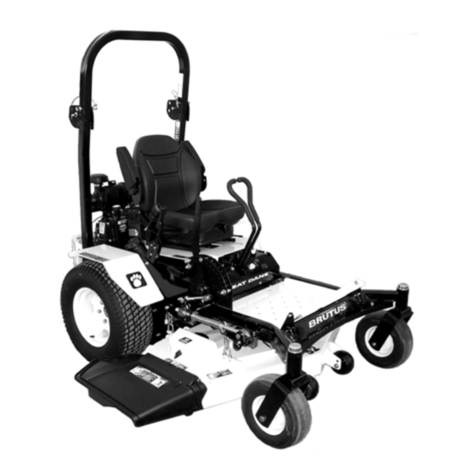Great Dane GDWG17KAE User manual

cWARNING:The Engine Exhaust
from this product contains chemicals known
to the State of California to cause cancer,
birth defects or other reproductive harm.
California Proposition 65 Warning
OMGD10004 B2
D02-107
GD10004
B2
Gateway
GDWG17KAE, GDWG22KHE
OPERATOR’S MANUAL
North American Version
Litho in U.S.A.

Introduction
INTRODUCTION
Introduction
Using Your Operator’s Manual
This manual is an important part of your machine and
should remain with the machine when you sell it.
An engine manufacturer’s owner’s manual has been
provided with your machine. This will provide maintenance
and troubleshooting information for the engine installed in
your machine.
Reading your operator’s manual will help you and others
avoid personal injury or damage to the machine.
Information given in this manual will provide the operator
with the safest and most effective use of the machine.
Sections in your operator’s manual are placed in a specific
order to help you understand all the safety messages and
learn the controls so you can operate this machine safely.
You can also use this manual to answer any specific
operating or servicing questions.
The machine shown in this manual may differ slightly from
your machine, but will be similar enough to help you
understand our instructions.
RIGHT-HAND and LEFT-HAND sides are determined by
facing in the direction the machine will travel when going
forward. When you see a broken line (------), the item
referred to is hidden from view.
Special Messages
Your manual contains special messages to bring attention
to potential safety concerns, machine damage as well as
helpful operating and servicing information. Please read all
the information carefully to avoid injury and machine
damage.
NOTE: General information is given throughout the
manual that may help the operator in the operation or
service of the machine.
Record Identification Numbers
Gateway
GDWG17KAE Serial No. (414000 - 414999)
GDWG22KHE Serial No. (416000 - 416999)
If you need to contact an Authorized Service Center for
information on servicing, always provide the product model
and serial numbers.
You will need to locate the model and serial numbers for
the machine and for the engine of your machine and record
the information in the spaces provided.
DATE OF PURCHASE:
_________________________________________
DEALER NAME:
_________________________________________
DEALER PHONE:
_________________________________________
MX9259
MODEL NUMBER (A):
__ __ __ __ __ __ __ __ __ __ __ __ __ __ __ __ __
SERIAL NUMBER (POWER UNIT) (B):
__ __ __ __ __ __ __ __ __ __ __ __ __ __ __ __ __
ENGINE SERIAL NUMBER (B):
__ __ __ __ __ __ __ __ __ __ __ __ __ __ __ __ __
ENGINE SPECIFICATION NUMBER (C):
__ __ __ __ __ __ __ __ __ __ __ __ __ __ __ __ __
cCAUTION: Avoid injury! This symbol and text
highlight potential hazards or death to the
operator or bystanders that may occur if the
hazards or procedures are ignored.
IMPORTANT: Avoid damage! This text is used to tell
the operator of actions or conditions that might
result in damage to the machine.
A
B
C

Table of Contents
TABLE OF CONTENTS
All information, illustrations and
specifications in this manual are based
on the latest information at the time of
publication. The right is reserved to
make changes at any time without
notice.
COPYRIGHT© 2002
Deere & Co.
John Deere Worldwide Commercial and
Consumer Equipment Division
All rights reserved
Previous Editions
COPYRIGHT© 2001
OMGD10004 B2 - English
Table of Contents
Safety .....................................................................................................................................................................................1
Operating................................................................................................................................................................................6
Replacement Parts ...............................................................................................................................................................10
Service Intervals...................................................................................................................................................................11
Service Lubrication...............................................................................................................................................................12
Service Engine .....................................................................................................................................................................13
Service Transmission............................................................................................................................................................15
Service Mower......................................................................................................................................................................18
Service Electrical..................................................................................................................................................................21
Service Miscellaneous..........................................................................................................................................................24
Troubleshooting ....................................................................................................................................................................26
Storage.................................................................................................................................................................................29
Assembly ..............................................................................................................................................................................30
Specifications .......................................................................................................................................................................32
Index.....................................................................................................................................................................................33
Service Record GD ..............................................................................................................................................................34

Safety - 1
SAFETY
Safety
Understanding The Machine Safety Labels
MIF
The machine safety labels shown in this section are placed
in important areas on your machine to draw attention to
potential safety hazards.
On your machine safety labels, the words DANGER,
WARNING and CAUTION are used with this safety-alert
symbol. DANGER identifies the most serious hazards.
The operator’s manual also explains any potential safety
hazards whenever necessary in special safety messages
that are identified with the word CAUTION and the safety-
alert symbol.
DANGER/POISON
MX9292 MX9258
•Shield eyes explosive gases can cause blindness or
injury.
•No sparks, flames, smoking.
•Sulfuric acid can cause blindness or severe burns.
•Flush eyes immediately with water get medical help fast.
•Keep out of the reach of children.
•Do not tip.
•Keep vent caps tight and level.
CAUTION
MX9295 MX9258
•This product is designed for professional and
commercial users.
•Operation training is required.
•Carefully read safety instructions.
•Know function of controls before operating.
•Practice with cutter blades off until confident.
•Clear mowing area of all debris.
•Keep all guards, covers and shields in place while
working.
•Do not disable or bypass any safety device.
•Always wear safety goggles while operating.
•Always park machine on level surface.
•Avoid contact with cutter blades; They may be rotating.
•Keep children and others clear from area.
•Set ground speed control to safe speed.
•Slowly and smoothly move speed control levers to start
and stop machine.
•Reduce speed and avoid sharp turns.
•Be careful on slopes; do not mow where stability or
traction is in doubt.
•To obtain additional operator manual and safety
instructions, contact Great Dane dealer or write Great
Dane Power Equipment, 4700 New Middle Rd.,
Jeffersonville, IN 47130, USA.

Safety - 2
SAFETY
DANGER
MX9293 MX9258
•Keep hands and feet away.
CAUTION
MX9294 MX9258
•Do not operate mower without chute deflector, mulching
plate or complete grass catcher assembly in position.
•Do not remove grass catcher, mulching plate or raise
the chute deflector until engine and blade(s) have stopped.
Emission Control System Certification Label
(Small Off-Road Gas Engines)
NOTE: Tampering with emission controls and
components by unauthorized personnel may result in
severe fines or penalties. Emission controls and
components can only be adjusted by EPA and/or
CARB authorized service centers. Contact your Great
Dane Equipment Retailer concerning emission
controls and component questions.
The presence of an emissions label signifies that the
engine has been certified with the United States
Environmental Protection Agency (EPA) and/or California
Air Resources Board (CARB).
The emissions warranty applies only to those engines
marketed by Great Dane that have been certified by the
EPA and/or CARB and used in the United States and
Canada in off-road mobile equipment.
Emission Compliance Period (Small Off-Road
Gas Engines)
If your engine has the emission compliance category listed
on the emission control system certification or air index
label, this indicates the number of operating hours for
which the engine has been certified to meet EPA and/or
CARB emission requirements. The following table provides
the engine compliance period in hours associated with the
category found on the certification label.
Operating Safely
•Do not allow operation or service of the machine by
children or untrained adults.
•Read the operator’s manual and study the safety and
operation sections before operating the machine.
•Operate the machine in an open, unobstructed area
under the direction of an experienced operator.
•Learn the use of all controls.
•Operator experience is required to learn the moving,
stopping, turning and other operating characteristics of the
machine.
•Inspect machine before you operate. Be sure hardware
is tight. Repair or replace damaged, badly worn or missing
parts. Be sure guards and shields are in good condition
and fastened in place. Make any necessary adjustments
before you operate.
•Do not operate mower without discharge chute or entire
grass catcher in place.
•Check before each use that operator presence controls
are functioning correctly. Test safety systems. Do not
operate unless they are functioning correctly.
•Do not change the engine governor setting or
overspeed the engine.
•Check brake action before you operate. Adjust or
service brakes as necessary.
•Stop machine if anyone enters the area.
•Never raise mower decks when blades are running.
Agency Category Hours
EPA C 250
EPA B 500
EPA A 1000
CARB Moderate 125
CARB Intermediate 250
CARB Extended 500
This manual suits for next models
1
Table of contents
Other Great Dane Lawn Mower manuals
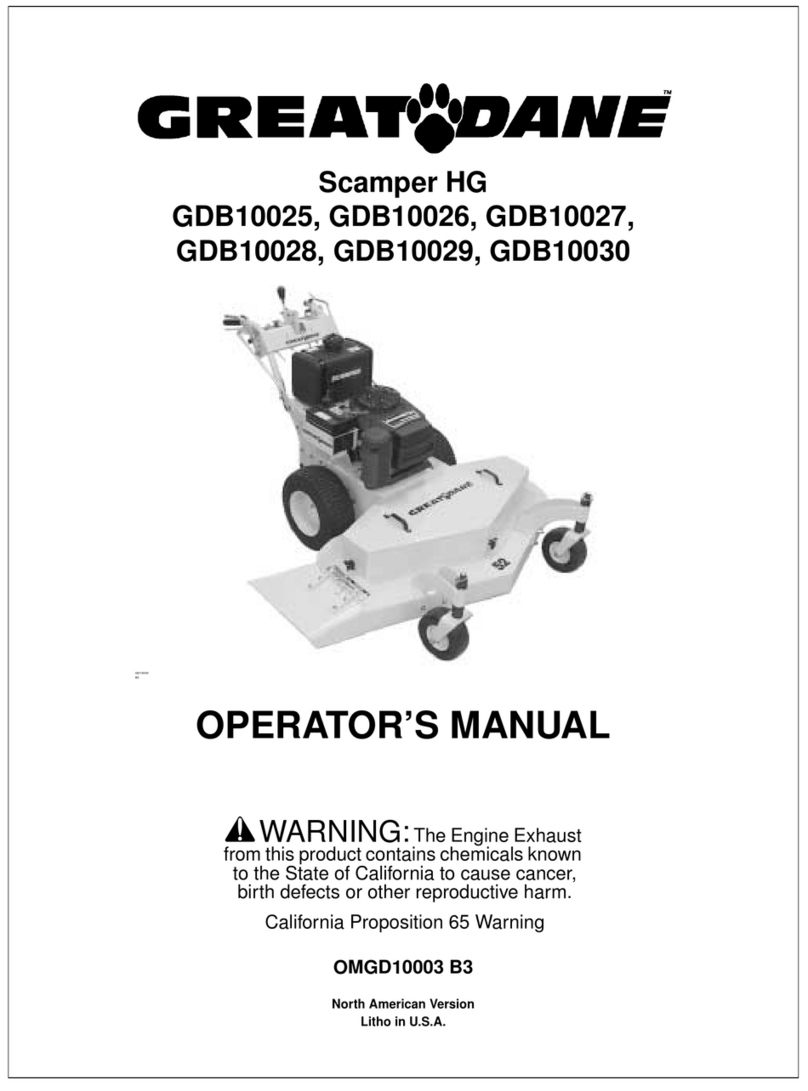
Great Dane
Great Dane Scamper HG GDB10025 User manual

Great Dane
Great Dane Chariot GCHKW1948S Owner's manual
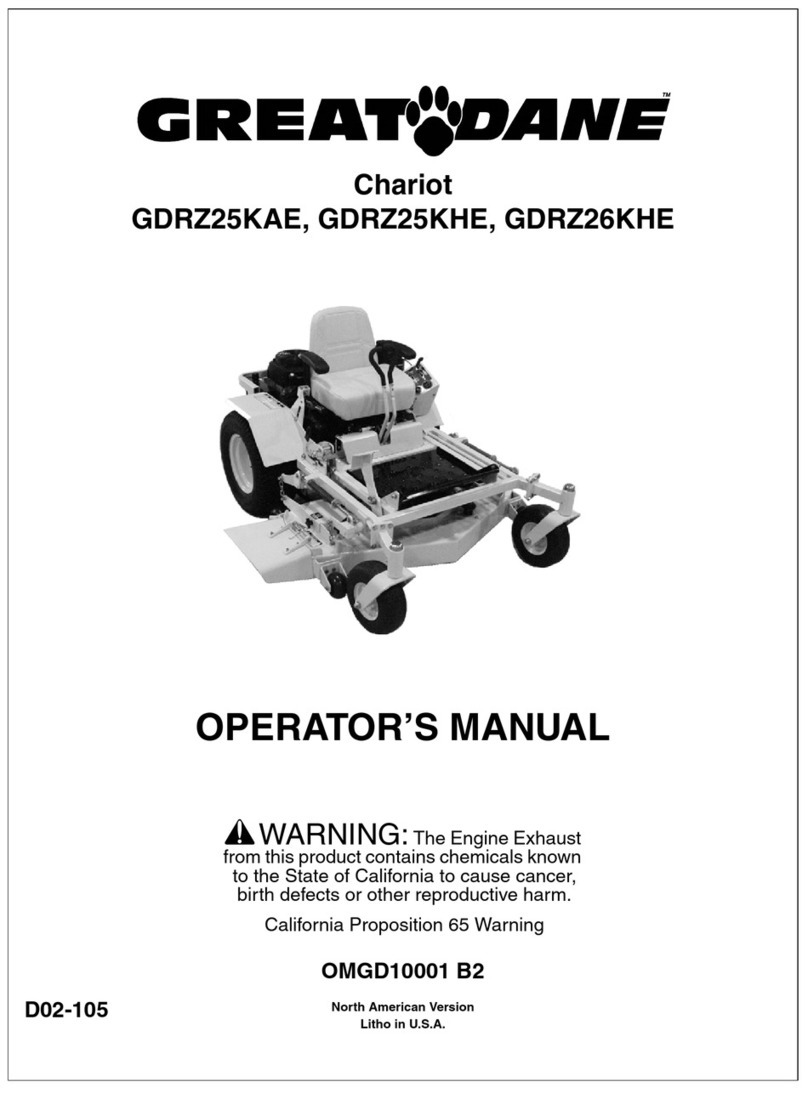
Great Dane
Great Dane Chariot GDRZ25KAE User manual

Great Dane
Great Dane Scamper Hydro GLKW1536S User manual
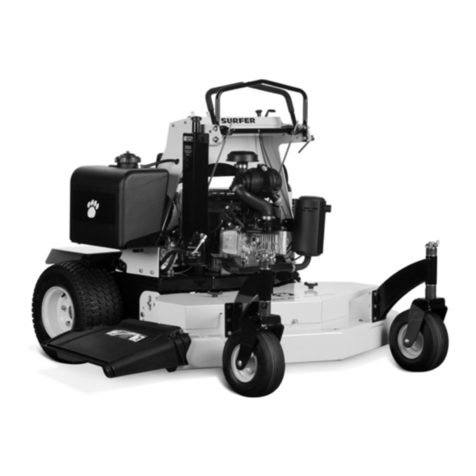
Great Dane
Great Dane Great Dane Surfer GSRKA1952S User manual
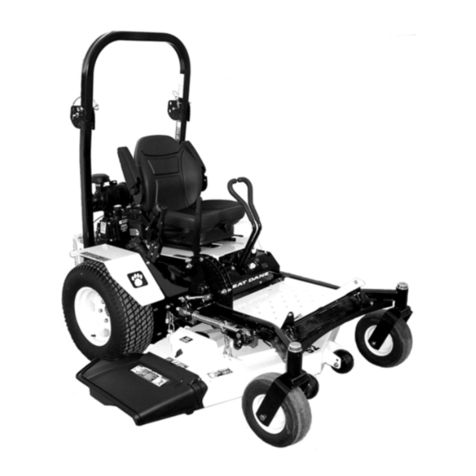
Great Dane
Great Dane C5 Chariot GCBR2661S User manual
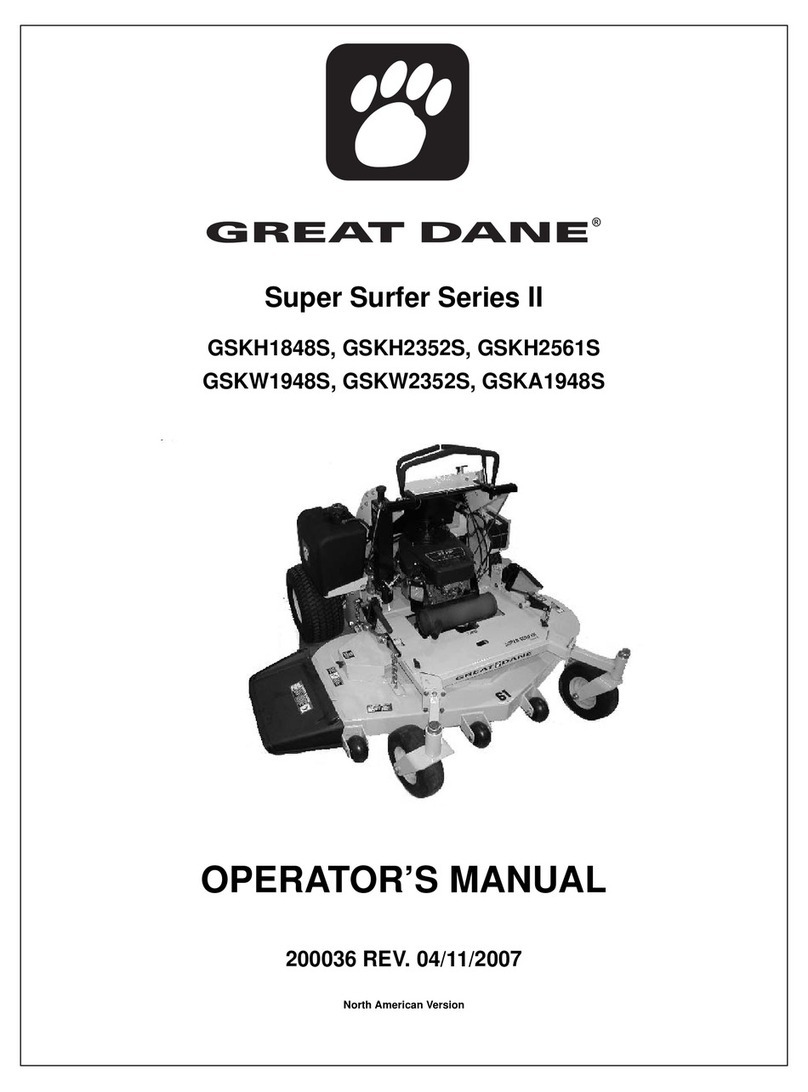
Great Dane
Great Dane Super Surfer Series II GSKH2352S User manual
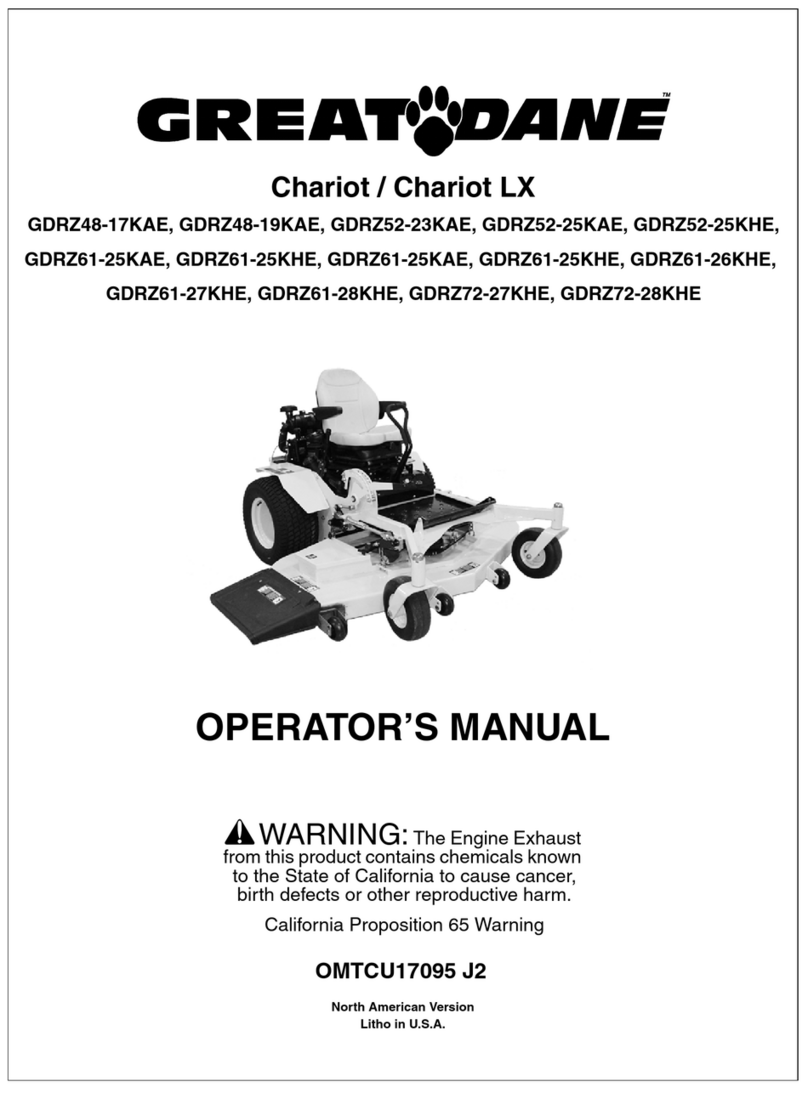
Great Dane
Great Dane Chariot / Chariot LX GDRZ48-17KAE User manual

Great Dane
Great Dane Scamper HG TCHE48-17KA Setup guide
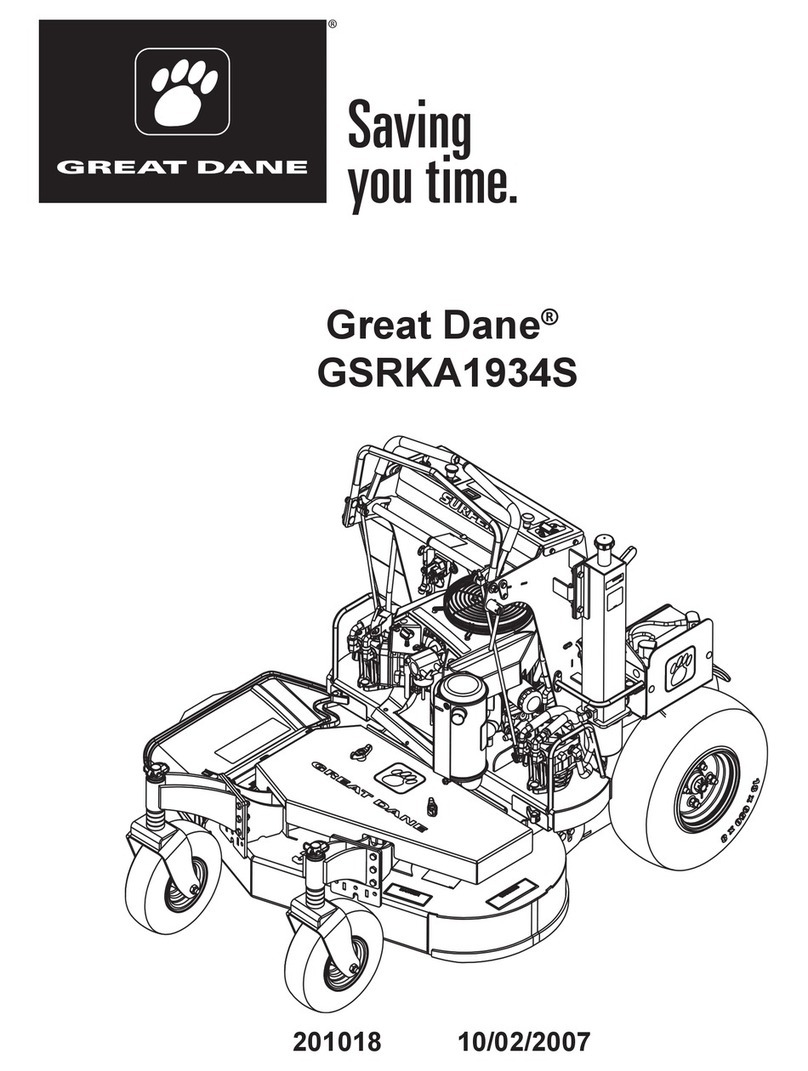
Great Dane
Great Dane GSRKA1934S User manual

